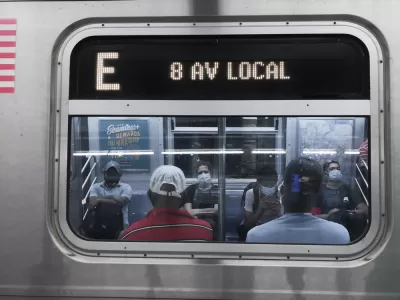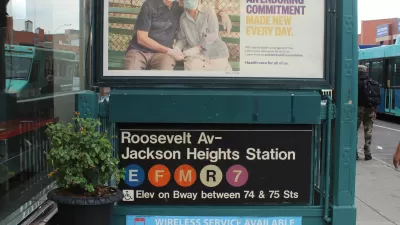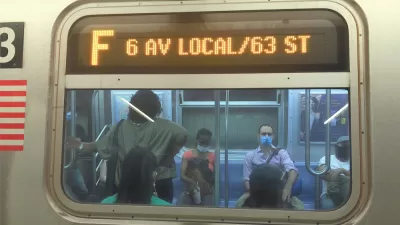Ridership on the New York Subway has a long way to go to return to pre-pandemic normal, and the setbacks of recent months haven't helped the cause.

The New York Times on Sunday published a big feature by Michael Gold, Ana Ley, and James Thomas that digs into the current status of subway ridership around New York City, nearly two years after Covid-19 emerged in its first, brutal wave in the Big Apple and produced one of the first obvious signs of the intersecting concerns of planning and the pandemic.
According to the article, the return of riders to the nation's premier subway system has been uneven depending on location. "Stations in lower-income areas in Brooklyn, Queens and Upper Manhattan, where residents are less likely to be able to work from home and typically depend more on public transit, have rebounded far faster than stations in office-heavy sections of Manhattan, including some that were once the busiest in the system, where many workers are still able to work remotely," write Gold, Ley, and Thomas.
Overall, ridership is still far below pre-pandemic levels. Average daily ridership in November was at 56 percent of pre-pandemic levels—a marked improvement from the 90 percent reduction in trips recorded in spring of 2020, but still far from normal. Recent challenges have worsened ridership—the Omicron variant has sickened Metropolitan Transportation Authority employees, leading to service cuts, and kept more potential riders at home.
"The system is also contending with fears about crime and public safety that were amplified after a woman was shoved to her death in front of a train on Saturday by a man at the Times Square station," according to the article.
Focusing on the varied experiences of the subway in 2022—depending on location and the surrounding economic and demographic factors—the article surveys multiple stations around the system for data and human interest anecdotes. Time lapse video at each station help capture some of the effect in the aggregate.
FULL STORY: Here’s Where Subway Riders Have Returned. And Where They Haven’t.

Alabama: Trump Terminates Settlements for Black Communities Harmed By Raw Sewage
Trump deemed the landmark civil rights agreement “illegal DEI and environmental justice policy.”

Planetizen Federal Action Tracker
A weekly monitor of how Trump’s orders and actions are impacting planners and planning in America.

The 120 Year Old Tiny Home Villages That Sheltered San Francisco’s Earthquake Refugees
More than a century ago, San Francisco mobilized to house thousands of residents displaced by the 1906 earthquake. Could their strategy offer a model for the present?

In Both Crashes and Crime, Public Transportation is Far Safer than Driving
Contrary to popular assumptions, public transportation has far lower crash and crime rates than automobile travel. For safer communities, improve and encourage transit travel.

Report: Zoning Reforms Should Complement Nashville’s Ambitious Transit Plan
Without reform, restrictive zoning codes will limit the impact of the city’s planned transit expansion and could exclude some of the residents who depend on transit the most.

Judge Orders Release of Frozen IRA, IIJA Funding
The decision is a victory for environmental groups who charged that freezing funds for critical infrastructure and disaster response programs caused “real and irreparable harm” to communities.
Urban Design for Planners 1: Software Tools
This six-course series explores essential urban design concepts using open source software and equips planners with the tools they need to participate fully in the urban design process.
Planning for Universal Design
Learn the tools for implementing Universal Design in planning regulations.
Clanton & Associates, Inc.
Jessamine County Fiscal Court
Institute for Housing and Urban Development Studies (IHS)
City of Grandview
Harvard GSD Executive Education
Toledo-Lucas County Plan Commissions
Salt Lake City
NYU Wagner Graduate School of Public Service





























